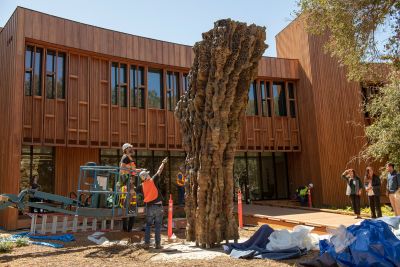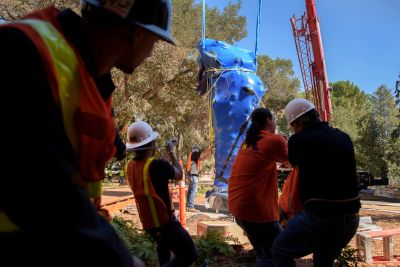When the inaugural cohort of Knight-Hennessy Scholars arrive to Stanford, they will be greeted by a new sculpture in front of Denning House, their program’s new home.
The sculpture, MOCNA, by Ursula von Rydingsvard, was commissioned as the first piece in Denning House’s art collection, which plans to acquire one piece every year from emerging and established artists poised to make a lasting impact in the arts.
“Ursula von Rydingsvard’s MOCNA is a fitting inaugural work for the new collection,” said Roberta Bowman Denning, ’75, MBA ’78, who sits on the Denning House art committee and is the former chair of Stanford’s Arts Advisory Council. “It is a powerful sculpture, with delicate pierced openings and gentle evening light, and will serve as a beacon for both scholars and visitors.”

Image credit: L.A. Cicero

Image credit: L.A. Cicero

Image credit: L.A. Cicero

Image credit: L.A. Cicero

Image credit: L.A. Cicero

Image credit: L.A. Cicero

Image credit: L.A. Cicero

Image credit: L.A. Cicero

Image credit: L.A. Cicero
Von Rydingsvard’s large-scale abstract work – MOCNA is an impressive 17 feet – reveals both the traces of the human hand and the forces of nature in its bronze structure. Her art is represented in the permanent collections of over 30 museums and is on view in multiple public locations across the country.
“Von Rydingsvard’s use of bronze transcends traditional processes, incorporating metallic fretwork and internal LED illumination. Positioned at the threshold of Denning House, the monumental work commands the attention of those who enter,” said Susan Dackerman, the John & Jill Freidenrich Director at the Cantor Arts Center. “MOCNA joins a distinguished collection of sculptures at Stanford, including one of the largest collections of works by Rodin in the U.S. at the Cantor.”
While MOCNA is the first commissioned piece in the new collection, Denning House has also acquired two works by the artist Trevor Paglen: Matterhorn (How to See Like a Machine) Brute-Force Descriptor Matcher; Scale Invariant Feature Transform (2016) and Lake Tenaya Maximally Stable Extremal (2016). These dye sublimation prints consider the ways that machines understand images, and the gap between recognition and understanding.
Go to the web site to view the video.
Paglen’s work is displayed on both floors of Denning House and can be seen on one of the monthly tours of the building, which begin in the spring. The public can view MOCNA anytime on the north side of Denning House.
“The Denning House Collection is meant to incorporate contemporary art into the daily experience of the scholars, contributing to their formation as thoughtful and humanistic leaders,” said Roberta Bowman Denning. “In addition to close encounters with a growing art collection, scholars will also have multiple opportunities for informal engagement with artists making an impact in our contemporary culture.”
A gift from Roberta Bowman Denning and her husband, Steven A. Denning, MBA ’78, past chair of the Stanford Board of Trustees, made the building and art acquisition possible. Denning House will serve as a hub for the Knight-Hennessy Scholars as they pursue their graduate work in departments across campus. Ennead, the architectural firm behind Bing Concert Hall and the Anderson Collection building in Stanford’s arts district, designed the building.
Announced in 2016, the Knight-Hennessy Scholars program aims to develop a community of future global leaders to address complex challenges through collaboration and innovation. Students selected as scholars receive full funding to pursue graduate studies at Stanford. The 51 graduate students in the inaugural cohort of Knight-Hennessy Scholars will participate in the King Global Leadership Program and community building activities.
Media Contacts
Ari Chasnoff, Knight-Hennessy Scholars: chasnoff@stanford.edu, (650) 721-0771
Robin Wander, University Communications: robin.wander@stanford.edu, (650) 724-6184